Northeast Indian Cuisine is a diverse culinary tapestry reflecting the vibrant cultures of the region's states, including Assam, Manipur, Nagaland, and more. Known for its unique flavors, the cuisine often features indigenous herbs, bamboo shoots, and fermented ingredients. Staples like rice and fish are prevalent, but each state contributes distinct dishes, from Assam's flavorful fish curries to Nagaland's fiery pork preparations. The use of aromatic spices and organic, locally sourced ingredients defines the culinary landscape. Northeast Indian Cuisine offers a gastronomic adventure, showcasing the rich biodiversity and cultural heritage of this lesser-explored culinary gem in the heart of India.
Pitha
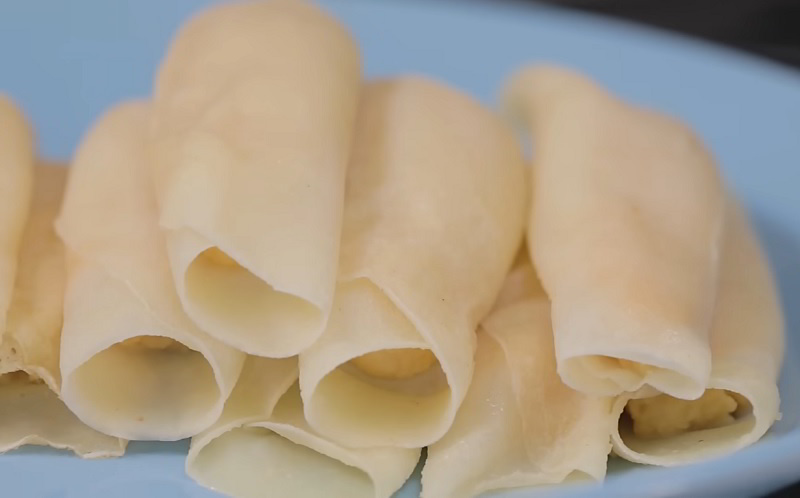
Pitha is a traditional dish that holds a significant place in the culinary landscape of Northeast India. It is a versatile and delectable dish, mostly prepared during festivals and special occasions. Pithas are essentially rice-based pancakes or dumplings, prepared using a variety of ingredients and cooking methods. The key ingredients used in making pitha are rice flour, jaggery (unrefined sugar), coconut, and sometimes, lentils. The dough is prepared by mixing rice flour with water, and then it is shaped into various forms like dumplings, pancakes, or even stuffed pockets. These are then either steamed, grilled, or fried, depending on the type of pitha being made. The flavors of pitha can vary greatly, ranging from sweet to savory. Sweet pithas are often stuffed with a mixture of grated coconut, jaggery, and cardamom, creating a delightful combination of flavors. Savory pithas, on the other hand, may be filled with spiced lentils or vegetables, providing a savory and satisfying taste.
Pithas are not only delicious but also visually appealing, as they come in different shapes and sizes. They are often served as a snack or dessert and are enjoyed with a cup of tea or milk. Pitha showcases the rich culinary heritage of Northeast India and is a beloved dish that brings people together during festive occasions.
Akhuni
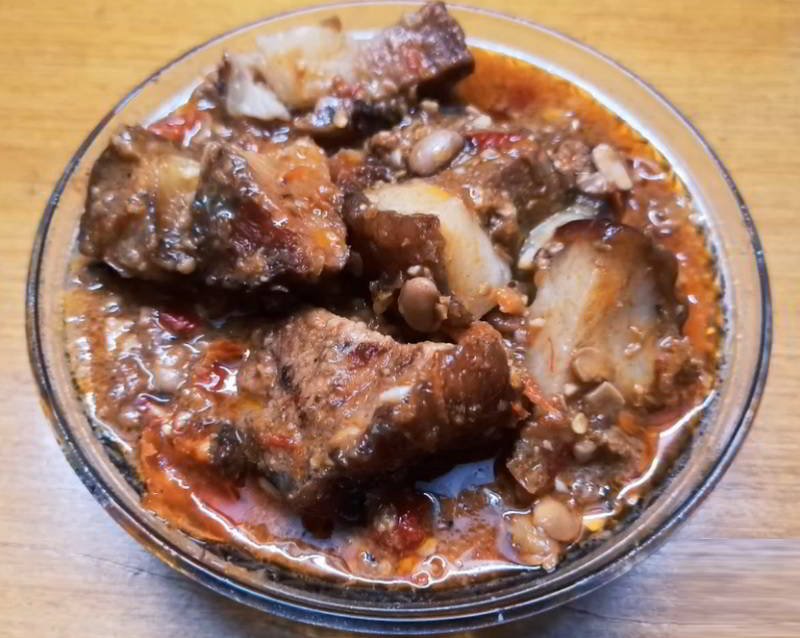
Akhuni is a traditional delicacy from the Northeast Indian cuisine that is popularly served in Nagaland. It is a rich and flavorful dish made with fermented soybeans called akhuni. The preparation of akhuni involves soaking soybeans in water and allowing them to ferment for several days, resulting in a distinctive pungent aroma. To make Akhuni dish, the fermented soybeans are first cooked and mashed into a paste. This paste is then sautéed with a combination of spices and ingredients such as onions, garlic, ginger, and chili peppers. The dish is often cooked with meat, such as pork or smoked fish, to enhance its taste and add additional texture. Akhuni dish has a unique and complex flavor profile, with a strong umami taste from the fermented soybeans. It is often enjoyed with steamed rice or bread, and the combination of the rich, savory flavors makes for a satisfying and hearty meal.
This traditional dish is not only a staple in Nagaland but also holds cultural significance, often being served during festivals and special occasions. Akhuni dish represents the rich culinary heritage of Northeast India and is a must-try for those looking to explore the diverse flavors of the region.
Panta Bhat
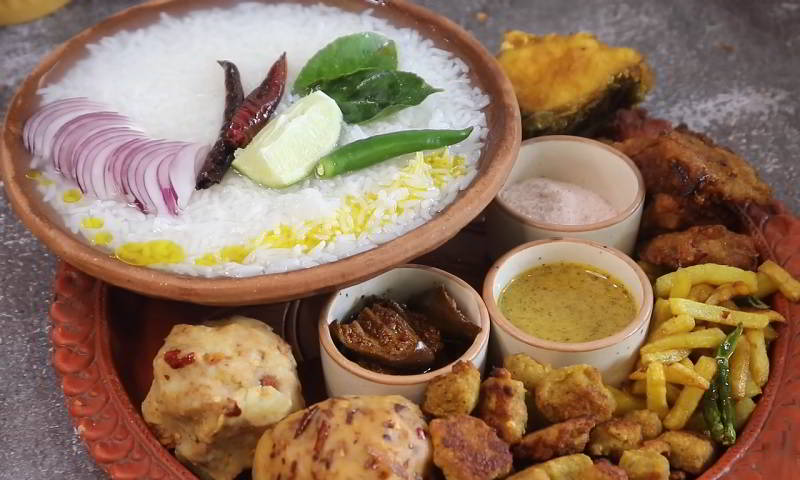
Panta Bhat or Poitabhat, a traditional culinary gem, is a rice-based dish celebrated for its unique preparation and cultural significance. The dish involves soaking cooked rice, often leftovers, in water overnight, resulting in a fermented delight. The liquid part, known as Toraṇi, adds a distinctive flavor to this culinary creation.
Served traditionally in the morning, Panta Bhat captivates the palate with a medley of flavors. The dish is typically accompanied by chili, salt, onion, and mashed potatoes, creating a harmonious blend that delights the taste buds.
What sets Panta Bhat apart is its nutritional profile. Fermentation not only imparts a tangy taste but also enhances the micronutrient content of the rice, making it a wholesome and nourishing dish. In contrast to fresh rice, Panta Bhat offers a unique array of benefits and is considered beneficial in various conditions.
In Northeast India, Panta Bhat holds a special place, with a belief that consuming it imparts the strength of a tiger. This cultural association adds a layer of significance to the dish, making it not just a culinary delight but also a symbol of vitality and tradition in the region.
Singju
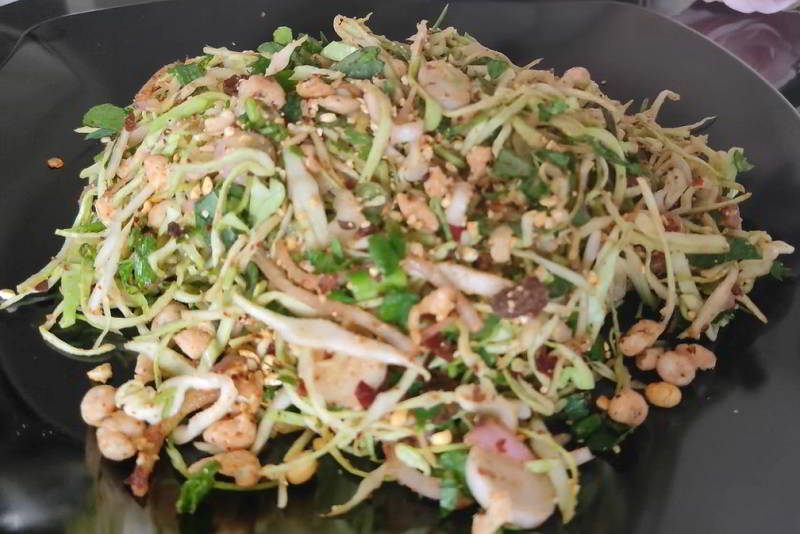
Singju is a traditional dish from Northeast India, particularly popular in the states of Manipur and Nagaland. It is a vibrant and flavorful salad that is often consumed as a side dish or a snack. Singju is made with a variety of fresh vegetables, herbs, and spices, resulting in a healthy and delightful culinary experience. The key ingredient in Singju is a mixture of different vegetables, including cabbage, lotus stem, cucumber, carrot, and radish. These vegetables are finely shredded and mixed together to create a colorful medley of flavors and textures. The salad is then seasoned with a tangy dressing made from mustard oil, tamarind pulp, and various spices like chili powder, roasted cumin powder, and salt. Singju is garnished with roasted peanuts, sesame seeds, and sometimes even dried fish or shrimp to add an extra layer of crunch and taste. The combination of fresh vegetables, zesty dressing, and crunchy toppings creates a harmonious balance of flavors in every bite.
This refreshing and nutritious dish is not only a delight for the taste buds but also a visual feast with its vibrant colors. Singju is often enjoyed during festivals and special occasions, bringing people together to savor the unique flavors of Northeast Indian cuisine.
Apo
-1706009204.jpg)
Apo is a traditional alcohol drink that originates from Northeast Indian cuisine. It is a refreshing and nutritious beverage made from fermented rice. The process of making Apo involves soaking rice in water for a few hours and then grinding it to form a coarse paste. This paste is then left to ferment for a few days, during which the natural yeasts present in the air and on the rice grains help in the fermentation process. Once the fermentation is complete, the mixture is strained to remove any solids, resulting in a smooth and slightly tangy liquid. The drink is usually served chilled and can be enjoyed plain or with a hint of sweetness by adding jaggery or sugar.
Apo is not only a delicious drink but also carries several health benefits. It is rich in probiotics, which aid in digestion and promote a healthy gut. It is also a good source of vitamins and minerals like iron and potassium. In Northeast Indian cuisine, Apo is often consumed during special occasions and festivals. Its unique taste and nutritional value make it a popular choice among locals and visitors alike.
Eromba
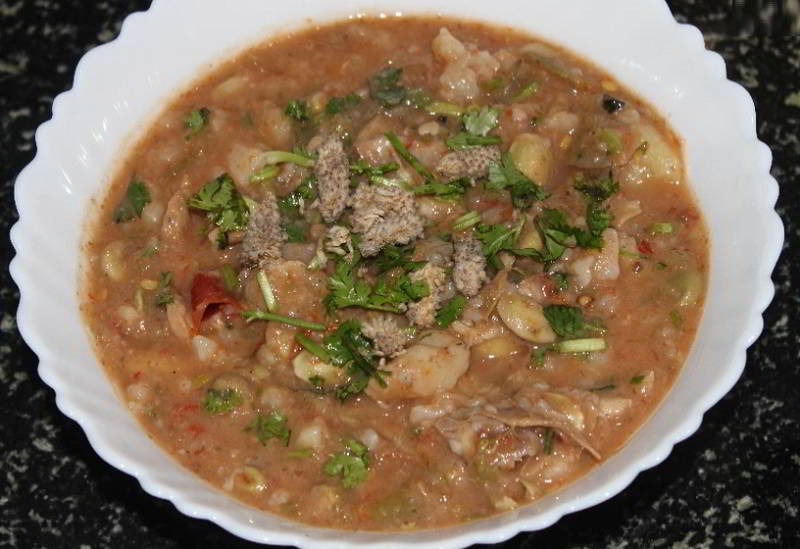
Eromba is a traditional dish from Northeast India that is popular among the Meitei community in Manipur. It is a unique and flavorful dish that perfectly represents the culinary traditions of this region. Eromba is essentially a combination of boiled vegetables, fermented fish, and chili, all mashed together to create a spicy and tangy dish. The key ingredients in Eromba include yongchak (a type of tree bean), ngari (fermented fish), and a variety of locally grown vegetables like potatoes, pumpkins, and lotus stems. These ingredients are cooked and then mashed together using a mortar and pestle to create a thick and chunky consistency. The dish is then seasoned with salt, chili, and sometimes garlic or ginger. One of the distinguishing features of Eromba is its strong and pungent flavor, which comes from the fermented fish. This gives the dish a unique umami taste that is loved by many.
Eromba is often served with rice or as a side dish with other Manipuri delicacies. Eromba is a delicious and wholesome dish that showcases the rich and diverse culinary traditions of Northeast India. Its bold flavors and unique combination of ingredients make it a must-try for anyone wanting to explore the cuisine of this region.
Chunga Pitha

Chunga Pitha is a traditional dish from Northeast India, particularly popular in the states of Assam and Meghalaya. This delectable dish is a type of rice cake, prepared using a unique cooking technique that makes it stand out from other Indian sweets. The process of making Chunga Pitha involves wrapping a mixture of rice flour, jaggery (a type of cane sugar), and grated coconut in banana leaves. These leafy parcels are then steamed or baked, allowing the flavors to infuse and create a harmonious blend of sweet and fragrant aromas. The final product is a soft, sticky, and slightly chewy rice cake with a rich and sweet filling. The banana leaves impart a subtle earthy flavor that complements the sweetness of the jaggery and the creaminess of the coconut.
Chunga Pitha is often enjoyed as a snack or dessert during festivals and special occasions. Its unique taste and texture make it a beloved treat in the region, and it is often served with a cup of hot tea. So, if you ever find yourself in Northeast India, don't miss the opportunity to savor the delightful flavors of Chunga Pitha.
Sulai

Sulai, a formidable distilled spirit originating from the state of Assam in Northeast India, goes by different names, including tharra in North India and handia or pheni in Nepal. Informally, it is often referred to as country liquor. Typically derived from fermented molasses or occasionally rice, Sulai is crafted through a traditional process where molasses or unrefined treacle undergo fermentation in a large tin or drum. The fermented molasses are then distilled continuously in a sizable cylindrical metallic vessel over firewood in an earthen oven, with water replaced multiple times during the heating process. The resulting condensed Sulai is collected in a small metallic vessel, and its strength is influenced by the frequency of water replacement, indicating higher untreated alcohol content with fewer water replacements. Stored in clear glass bottles, Sulai emits a robust, pungent odor, prompting its production in open fields or away from residential areas. Due to its single distillation process, Sulai boasts a high alcohol content, reaching levels of 40-45%, categorizing it as a rectified spirit.
Sulai is typically enjoyed neat, without the addition of water, often accompanied by fried meat or various curries. Historically, this beverage has been linked to lower caste ethnic groups, bearing a stigma that positions it as a drink associated with the 'lowly' classes. Scholars argue that elites have played a role in perpetuating this association, shaping the perception of Sulai consumption within societal contexts.
Chuak

Chuak, a traditional rice beer, holds a cherished place in the cultural tapestry of Tripura and the broader landscape of Northeast India. Crafted through a process of fermenting rice in water, this libation has become an integral part of Tripuri ceremonies and social gatherings. Brewed with care and tradition, Chuak is not merely a beverage but a symbol of communal togetherness and celebration. It takes center stage during various Tripuri ceremonies, where its consumption becomes a ritual, fostering a sense of unity and shared joy among the participants.
Particularly notable is the custom of offering Chuak to village elders during any significant occasion or celebration in a traditional Tripuri family. This act of sharing Chuak extends beyond the beverage itself, symbolizing respect for elders and a communal bond that transcends generations.
As the mellow notes of Chuak are raised in toasts during social occasions, it becomes a conduit for strengthening familial and community ties. Its presence is not just felt in the flavor but in the shared moments of joy, making Chuak a cultural emblem that embodies the spirit of Tripuri traditions.
Judima
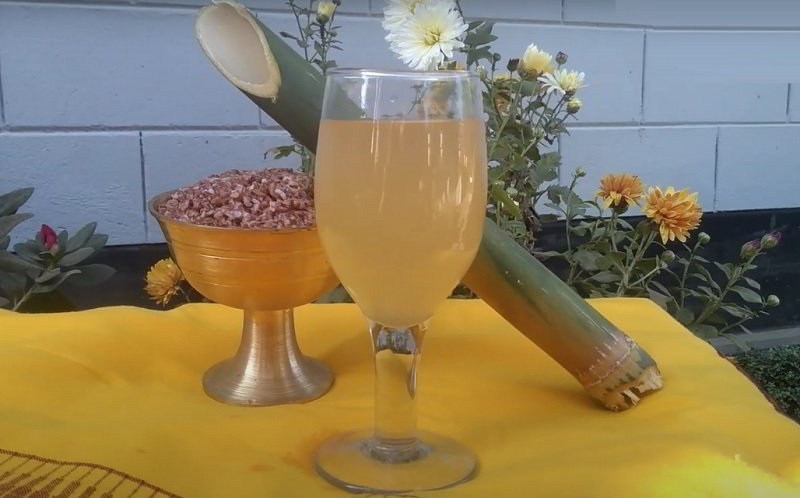
Judima, a traditional rice wine, stands as a proud emblem of the cultural heritage of the Dimasa people of Assam. In 2021, this age-old elixir received the coveted geographical indication tag, cementing its significance in the rich tapestry of Assamese traditions.
Crafted with meticulous care, Judima is prepared from a starter kit, with a distinctive touch that sets it apart—the infusion of a wild herb known as thembra (Acacia pennata), native to the Dima Hasao district. This herb not only adds a unique flavor but also contributes to the wine's distinct identity.
More than just a beverage, Judima holds a sacred role in the rituals of the Dimasa community. It is an integral part of ceremonies marking the pivotal moments of life, including birth, marriage, and death. The wine's ritualistic use underscores its cultural importance, serving as a symbolic thread that weaves through the fabric of Dimasa traditions. As the flavors of Judima tantalize the palate, it also serves as a reminder of the deep-rooted connections between communities and the significance of preserving age-old practices in the evolving landscape of Assam.
Handesh

Handesh, a delightful confection, is a culinary masterpiece created from a harmonious blend of rice flour, black sesame seeds, jaggery (unrefined sugar), and grated coconut. This unique combination results in a sticky dough-like consistency, which is carefully rolled into small round balls and steamed to perfection.
The steamed Handesh balls offer a sensory delight with their soft, slightly chewy texture. Served hot, they present a captivating symphony of flavors—a nutty undertone from the black sesame seeds, the natural sweetness of jaggery, and the gentle fragrance of coconut—all merging into a delightful experience for the taste buds.
Beyond its gastronomic appeal, Handesh holds cultural significance, particularly in Assam, India, where it is known as Tel Pitha. This delectable treat is not just reserved for the palate; it often takes center stage during festive occasions and celebrations, symbolizing joy, togetherness, and the rich cultural heritage of the region.
The simplicity and versatility of Handesh contribute to its widespread popularity, captivating both locals and tourists alike. As a sweet snack or dessert, Handesh stands as a testament to the culinary artistry embedded in Northeast Indian traditions.
Ngari
-1706024539.jpg)
Ngari, a culinary treasure originating from Manipur, is a fermented fish product deeply ingrained in the gastronomic traditions of the region. This indigenous delicacy, deriving its name from the Meitei language, reflects the essence of Manipuri culture. "Nga" translates to fish, and "ri" signifies the process of fermentation, encapsulating the fundamental nature of Ngari.
Primarily used as a condiment, Ngari imparts a unique and intense flavor to various Manipuri dishes, including eromba, singju, morok metpa, kangshoi, and more. The intricate process of fermentation transforms the fish into a piquant and aromatic culinary companion, enhancing the overall culinary experience.
While native to Manipur, Ngari has transcended regional boundaries and found its way into the culinary practices of other northeastern states in India. This flavorful fish preparation stands not only as a testament to Manipur's rich culinary heritage but also as a symbol of cultural exchange within the diverse northeastern culinary landscape. Ngari is also consumed in other northeastern States of India.
Posola
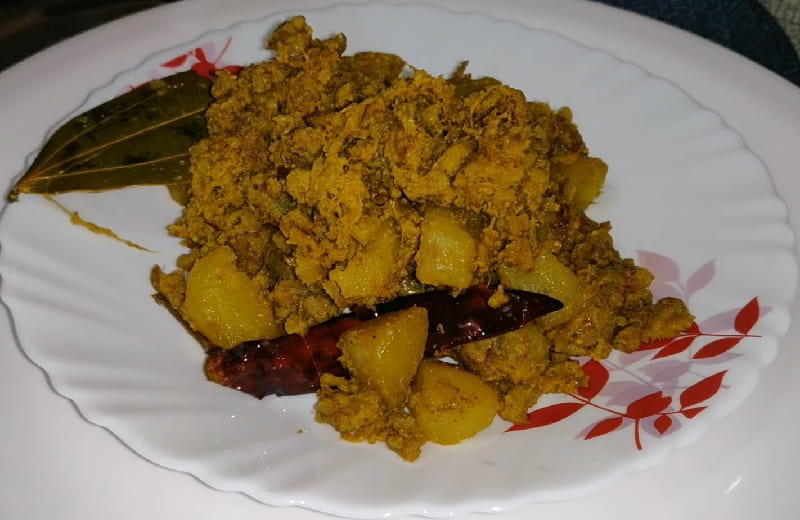
Within the realm of Assamese cuisine, Posola emerges as a delightful culinary creation meticulously fashioned from the tender inner part of banana shoots. The process involves peeling off the bark and cutting the tender inner portion of the banana stem into small pieces. In a kadhai, a blend of garlic, onions, mustard seeds, fenugreek seeds and cumin seeds is fried in oil until they splutter. Subsequently, the banana stem pieces are introduced into the aromatic mixture and simmered with hot water. As the water gradually evaporates, the flavors meld, resulting in a savory and tender Posola.
This culinary creation showcases the artistry of Assamese cooking, where simple yet vibrant ingredients are skillfully combined to yield a dish that reflects the region's rich gastronomic heritage.
Chicken Tikka Masala
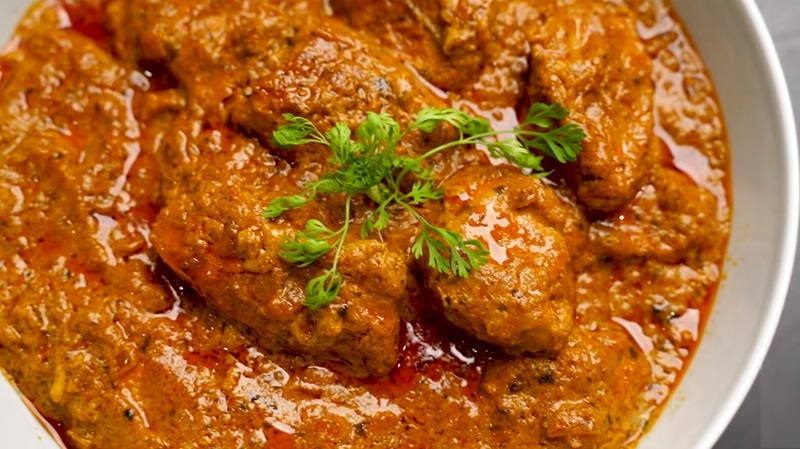
Chicken Tikka Masala, a culinary masterpiece that transcends borders, is a dish that has become synonymous with the fusion of Indian and British cuisines. This iconic creation consists of succulent, roasted, marinated chicken chunks known as "chicken tikka," bathed in a luscious, spiced sauce that typically boasts a creamy and vibrant orange hue.
The origins of Chicken Tikka Masala are rooted in the cultural exchange between Indian cooks residing in Great Britain. This dish has since gained global acclaim, gracing the menus of restaurants worldwide. Its popularity lies in the harmonious blend of flavors achieved through a meticulous preparation process.
To craft Chicken Tikka Masala, boneless chicken chunks undergo a flavorful marinade of spices and yogurt before being expertly roasted. The accompanying sauce, a key component of the dish, is renowned for its creamy texture and rich taste. While a tomato and coriander-infused sauce is common, variations abound, reflecting the diverse regional influences on the recipe.
Notably, the vibrant orange color of both the sauce and chicken pieces is achieved through the use of ingredients like paprika, turmeric, tomato purée, or food dye. Despite its widespread appreciation, the beauty of Chicken Tikka Masala lies in its adaptability, with diverse recipes offering a delightful array of interpretations to suit every palate.
Phall
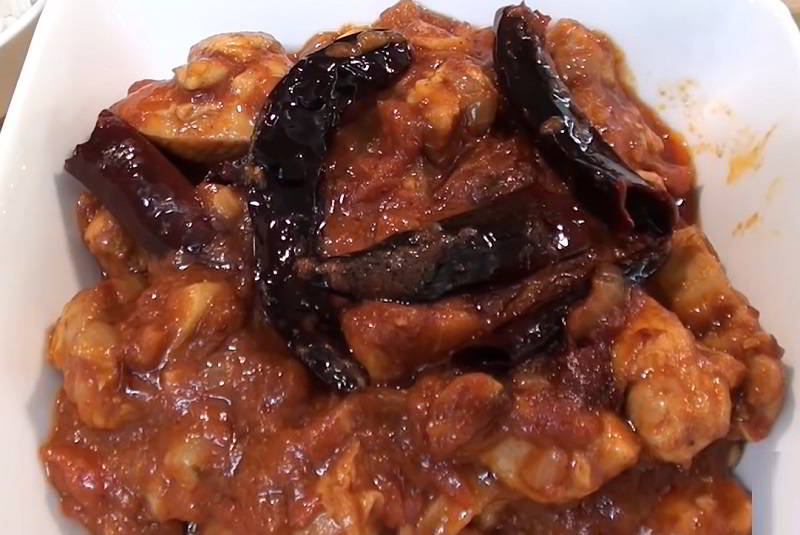
Phall, originating from British Indian cuisine, is renowned for its status as one of the spiciest curries available. The dish's roots can be traced back to the Bangladeshi community in the UK, particularly in Birmingham, where it gained popularity. It is known for its intense heat and rich taste, making it a favorite among spice enthusiasts. Known for its intense heat and bold flavors, Phall is traditionally made with a variety of hot chili peppers, often including the infamous Bhut Jolokia, also known as the ghost pepper, one of the world's spiciest peppers. The curry is prepared by incorporating these fiery peppers into a rich tomato-based sauce along with a mix of aromatic spices like cumin, coriander, and fenugreek, onion, ginger and garlic. To create Phall, meat, usually chicken or lamb, is marinated in a spicy mixture before being slow-cooked in the chili-infused sauce. The result is an incredibly fiery and flavorful curry that challenges even the most seasoned spice enthusiasts.
The dish can also be made vegetarian, with the addition of vegetables like potatoes or paneer. Phall's reputation as an extreme heat curry has made it a daring choice for those seeking an intense culinary experience. Phall is a dish for those who truly appreciate the heat and flavors of Northeast Indian cuisine. It is not for the faint-hearted, but for those seeking a culinary adventure that will leave a lasting impression.
Luchi
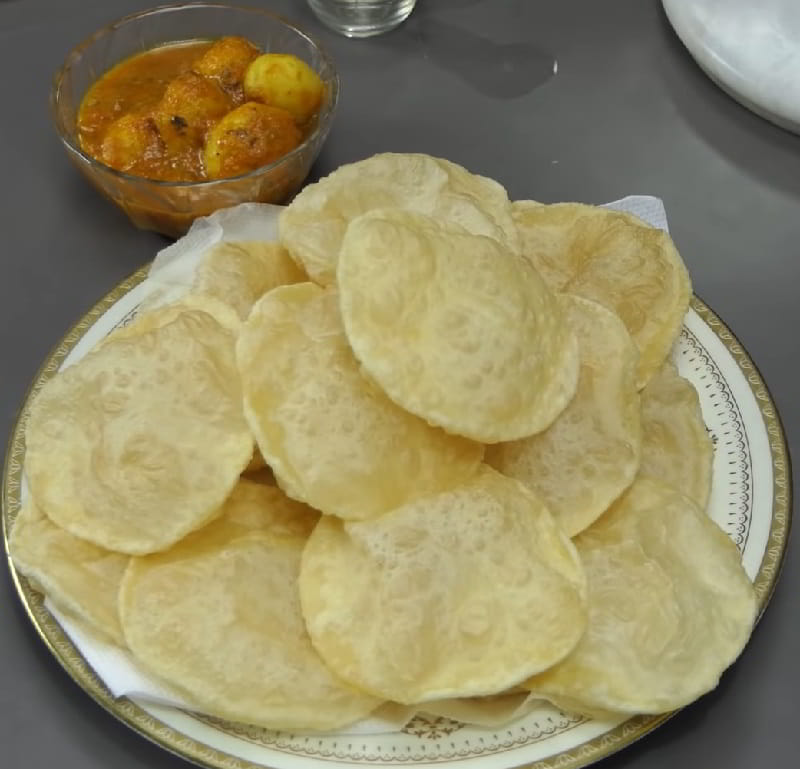
Luchi, a gastronomic delight originating from the Indian subcontinent, is a deep-fried flatbread celebrated for its irresistible taste and versatility. Crafted from Maida flour, this airy and fluffy bread has earned widespread acclaim, particularly in the Indian states of Uttar Pradesh, Odisha, West Bengal, Madhya Pradesh, Bihar, Assam, Tripura, and in the neighboring country of Bangladesh.
Notably, Luchi has become a culinary star when accompanied by dishes like aloor dum or kosha mangsho, offering a symphony of flavors that captivates the taste buds. What sets Luchi apart is its composition, avoiding the use of rice or rice flour. This characteristic makes it a preferred staple in instances where rice consumption is restricted, as observed during rituals like ekadashi or similar occasions.
During vegetarian-centric rituals, Luchi takes center stage, often paired with delectable vegetarian dishes like dum aloo. On less restrictive occasions, the classic combination of Luchi and kosha mangsho, a flavorful meat curry, enjoys immense popularity.
Adding to its allure, Luchi finds itself harmoniously partnered with Ghugni, creating a beloved breakfast or street food combination that showcases the culinary diversity and richness of the region. Whether savored during festive occasions or as a street-side treat, Luchi continues to enchant food enthusiasts with its delightful taste and cultural significance.
Aloo Chat
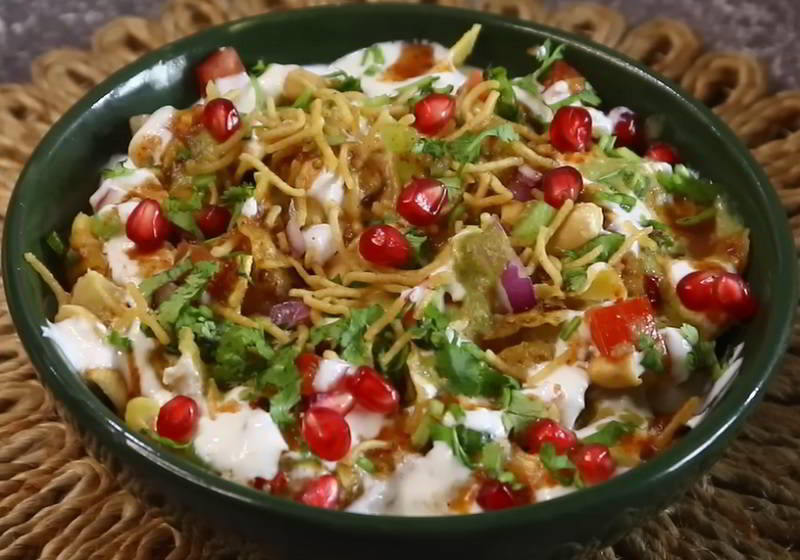
Aloo Chaat, a popular street food originating from North India, is a flavorful and tangy dish that showcases the versatility of potatoes. This savory delight involves boiled potatoes, cut into cubes, and then tossed with an assortment of spices and chutneys. A medley of ingredients like chaat masala, cumin powder, chopped onions, fresh coriander, tamarind chutney, and mint chutney add layers of taste and texture to the dish. The preparation of Aloo Chaat varies regionally and even among street vendors, offering a unique experience for every palate. Some versions include crispy fried noodles (sev) or pomegranate seeds for an extra burst of flavor. The dish embodies the essence of Indian street food, offering a delightful combination of spicy, tangy, and sweet flavors.
Aloo Chaat is not only a beloved snack enjoyed at roadside stalls but has also found its way into restaurant menus, parties, and family gatherings. Its simplicity, combined with an explosion of flavors, makes it a perennial favorite, inviting people to savor the diverse and delightful taste of Indian street cuisine.
Tungtap
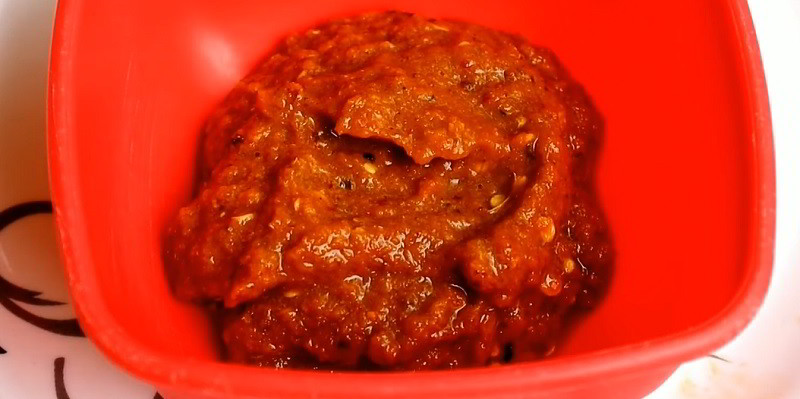
Tungtap, an integral component of Meghalayan cuisine, is a fermented fish paste relished by the Khasi and Garo communities. Much like hentak, Tungtap is meticulously crafted using pool barb fish or Indian flying barb, subjected to a process of sun-drying, salting, and fermentation within a sealed earthenware vessel. This vessel is carefully sealed with pandan leaves and secured with threads. Tungtap's versatility is showcased as it can be employed in curries, paired with rice, or transformed into a flavorful pickle or chutney by combining it with onions, garlic, chillis, and Zanthoxylum nitidum.
With its distinctive spongy and soft texture, Tungtap not only adds depth to Meghalayan dishes but also stands as a testament to the culinary artistry of the Khasi and Garo people.
Kargyong

Kargyong, a culinary gem hailing from the picturesque landscapes of Sikkim, stands as a testament to the rich tapestry of flavors found in the Himalayan region. This distinctive sausage, crafted with precision by the Sherpa, Lepcha, Bhutia, Tibetan, and Drukpa communities, encapsulates the diverse gastronomic heritage of the area.
The key ingredients of Kargyong include beef, yak, or pork seasoned with a blend of garlic, ginger, and salt. Encased in a natural casing known as gyuma, the sausage undergoes a meticulous preparation process. Boiled, smoked, and dried for a minimum of 10 days, and often extended to 15 days or more, Kargyong achieves a unique texture and flavor profile.
This delectable creation finds its way onto the tables of local restaurants, food stalls, and households in Sikkim, the Darjeeling Himalayan hill region, Bhutan, Tibet, and Ladakh. Beyond being a boiled delicacy, Kargyong takes on various avatars – fried with aromatic spices for curry, savored plain with regional beverages like raksi or chhaang, showcasing its versatility in Himalayan cuisine.






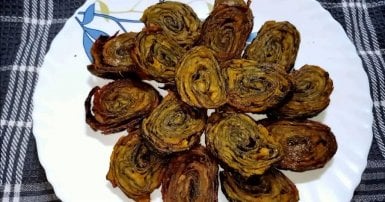
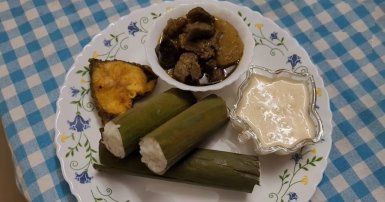

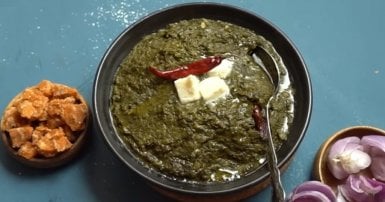
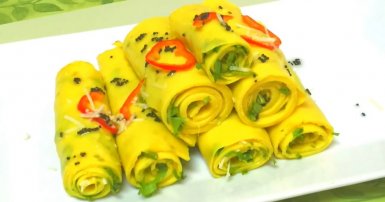


-1709813013.jpg)


